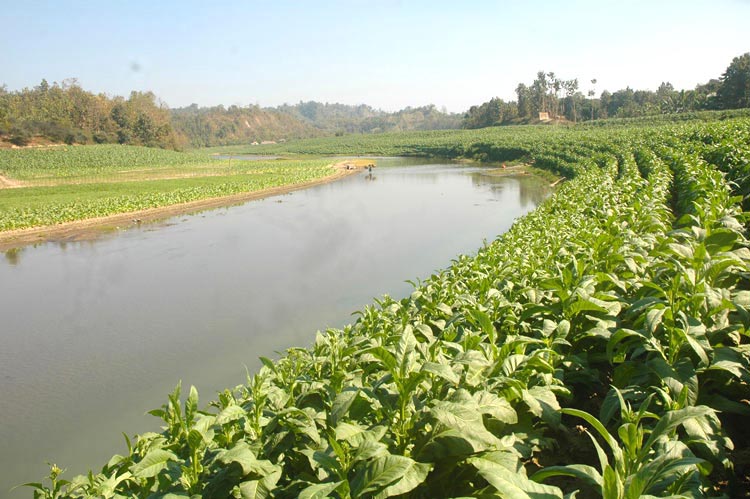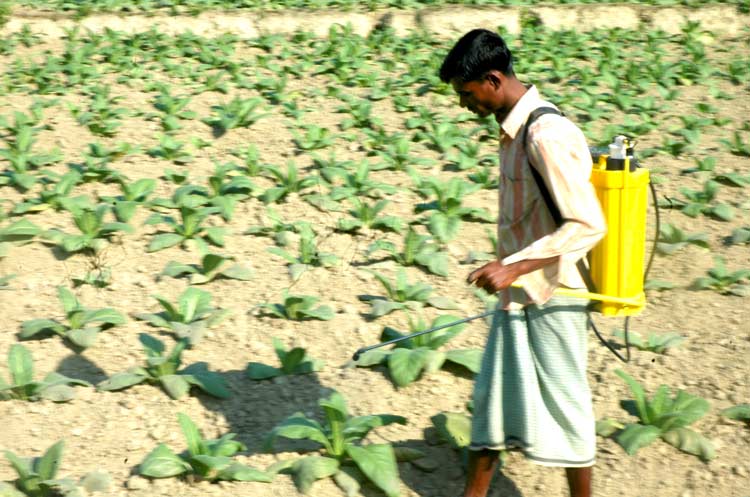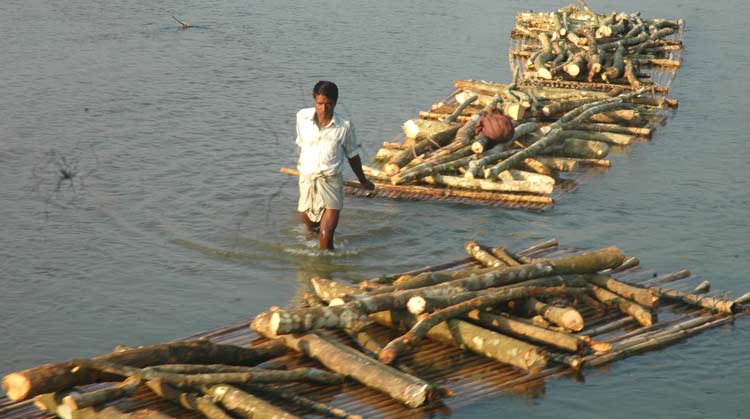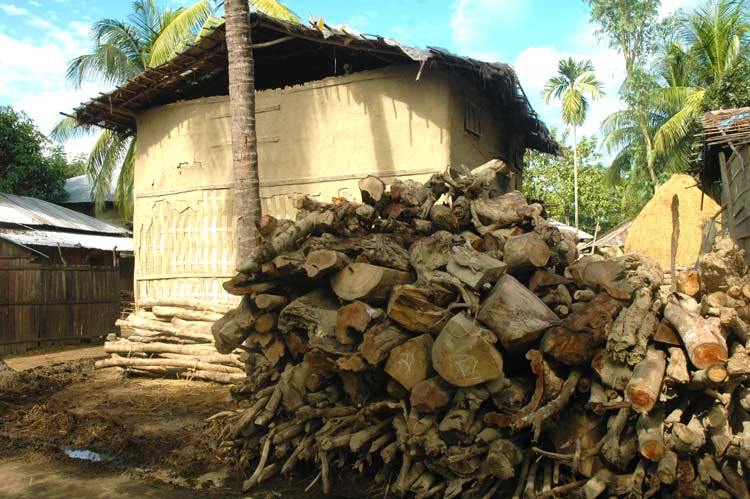
Farida Akhter
Tobacco cultivation in Bangladesh has always been river-based to exploit the fertile soil. Tobacco, mostly Flue Cured Virginia (FCV) and Barley variety, is a company sponsored crop grown since the last five decades. According to official data for 2016, tobacco is grown on 46,472 hectares of land, producing 87,628 tons of tobacco leaf. Bangladesh ranks 14th for area under tobacco, 12th for production in quantity, and has a share of 1.3% of global tobacco production (FAOSTAT 2018).
Tobacco cultivation has been expanded in Bangladesh, not due to increased interest of the farmers, but to appropriate fertile lands, source of fuel woods and water accessible for the tobacco industry. Fertile soil condition is an important factor for quality tobacco leaf production. British American Tobacco Company (BATC) started tobacco cultivation in Rangpur district in the fertile Teesta silt in the early 1970s, later on moved to Kushtia in the fertile land of the Gangetic Flood plain and then to the Chittagong Hill Tracts mostly for the fertile riverbeds of river Matamuhuri and the trees in the hill forest (Akhter 2011). In essence, the expansion of tobacco production is a corporate grabbing of fertile land, forests for fuel woods and water, for which investors had to pay nothing.

Tobacco, Nicotiana tabacum, grown as a monocrop, needs various kinds of chemical fertilizers, pesticides and fungicides to curb the growth of diseases and persistent weeds. The plant extracts nitrogen, phosphorus and potassium from the soil more rapidly than other crops – a problem exacerbated by practices such as topping and suckering that promote the concentration of nicotine in the plant’s leaves (CTFK 2001; Geist et al. 2009). Tobacco is not merely a plant, but a toxic industrial technology.
The introduction of tobacco along with its agro-chemical based toxic cultivation methods, is basically a promotion of an ‘alien invasive species’ in the biodiverse agrarian systems of Bangladesh. Monocultural invasion of non-indigenous species, or “non-native”, plants or animals adversely affect the habitats and bioregions by destroying food, fuel and water sources of the local communities. Due to its production pattern, tobacco has multiple impacts on food security, human health, social structures and the environment.
Matamuhuri, one of the biggest rivers originating from the Chittagong Hill Tracts, is the lifeline for the people of two districts, Cox’s Bazar and Bandarban, mostly the indigenous people. The river has numerous branches of canals and little fountains making the area beautiful and prosperous. Flowing westwards it falls into the Bay of Bengal forming a broad delta, consisting of groups of islets intersected by a network of tidal creeks and covered by mangrove vegetation. The river banks are flooded once a year thus they maintain a good soil health.
Bandarban once was known for growing diverse food crops like paddy, maize, potato, eggplant, long gourd, bean, radish, cauliflower, cabbage, lemon, papaya, and banana, but since tobacco cultivation started the area turned into a food deficit district.
Tobacco cultivation started in the fertile river banks of Matamuhuri in the 1980s by British American Tobacco Company (BATC), Dhaka Tobacco (in joint venture with Philip Morris International), Abul Khair and Akij Tobacco joined later. At present tobacco farming occupies the banks of the river at a length of about 80 km.
Impact on Soil
Tobacco plants exhaust soil nutrients (phosphorus, nitrogen, potassium) and thus tobacco monocropping requires substantial doses of chemical fertilizers. In addition, agrochemicals such as insecticides and herbicides are used extensively. Tobacco plots also contribute a lot to the accumulation of heavy metals in the soil (Moula et al. 2018).
In two consecutive years, 2015 and 2016, on-farm experiments were conducted in continuous tobacco based cropping pattern plots in Kushtia along with adjoining non-tobacco crop plots. In the first year, the average pH value of the tobacco plots was reduced significantly from 7.86 before cultivation to 7.56 after the harvest. Similarly, in the second year, the average pH value of these tobacco plots further decreased to 7.44 after harvesting. Additionally, potassium, phosphorous, sulfur and zinc in the soil were diminished on tobacco plots, thus leading to soil fertility depletion. Results from all tobacco plots showed that continuous farming of tobacco on the same plots reduces its fertility more than the consecutive farming of other crops such as rice and vegetables (Moula et al. 2018). Tobacco, therefore, requires a huge amount of fertilizer and chemical inputs. On the banks of Matamuhuri, about 2,000 tons of chemical fertilizers were used on 8,000 hectares of tobacco plots in 2009 (Akhter et al. 2012).
Chemical fertilizers are applied in the fields from land preparation to different stages of growth and development of tobacco plants. UBINIG field research shows that the required fertilizers are urea (nitrogen), triple superphosphate (TSP), diammonium phosphate (DAP), and sulphate of potash (SOP). Tobacco growers estimated that their urea use is 575 kg/ha and TSP use is 466 kg/ha. Excessive and imbalanced use of fertilizers like urea destroys the soil structure and texture. It lessens soil aeration, water holding capacity, micronutrients and also soil microbes (Akhter/Buckles/Tito 2014). Tobacco consumes 2.5 times the nitrogen, 7 times the phosphorus and 8 times the potassium as maize. Thus the land is depleted at a much faster rate than from traditional crops (Ali et al. 2015).
After continuous tobacco cultivation the soil becomes hard, dries up quickly or does not drain easily. The natural smell of the soil disappears and the soil color changes. These observations are indicators of the loss of soil organic matter, changes in soil chemical properties and loss of water-holding capacity (Akhter et al. 2012).
Another sign of soil degradation in tobacco growing areas is the parasitic plant Orobanche spp., locally called ‘mula’. Monocropping of tobacco favoured the development of this persistent weed that creates extra pressure on soil fertility as it grows extensively on the roots of tobacco plants, uptakes nutrients from the soil and dramatically reduces the tobacco plant’s growth. The control of Orobanche spp. is difficult and its continuous spread limits the choice of rotational crops (Abu-Irmaileh/Labrada 2018). Furthermore, tobacco roots do not decompose easily, but ‘mula’ develops from it and creates a problem for the next crop (Alim 2006).
Pesticides are applied in tobacco fields before sowing seeds in the seedbed, before and after transplanting seedlings in the field, at the growing stage of plants and at de-heading after flowering. Pesticides have at least 16 applications, using as many as 47 different brands sold in the open market. These include destructive pesticides like Ripcord, Furadon, Sumithion, Thiovit, and fungicides like Bavistin, Ridomil. All these have killing impacts on biological diversity thus affecting the soil.

UBINIG research also shows, that tobacco monocropping leaves the plant unable to protect the fertile top soil from corrosive elements. Farmers in the Matamuhuri area have calculated that more than 100 kilogrammes of top soil per hectare of land is lost per year. Tobacco farmers harvest the leaves, but do not clean the land from the tobacco roots. The decomposing roots of the plants create a “gas” in the soil and during rainy season the toxic soil gets into the river (Akhter et al. 2012).
Impact on Water
Water pollution from tobacco farming is caused by agrochemical residues in waterways adjacent to tobacco fields and exacerbated by reduced forest cover around the communities as also experienced in other countries such as Brazil. The shift to intensive tobacco production in ecologically fragile areas, such as wetlands, riparian zones and steep slopes, resulted in severe impact on hydrological systems and sediment yield (Merten/Minella 2006). Tobacco growing routinely involves fumigants like 1,3-Dichloropropene, insecticides like Aldicarb, Chlorpyrifos and Sumithion (organophosphate) as well as other herbicides, fungicides, growth inhibitors and ripening agents (Arcury/Quandt 2006).

Micro-environmental studies from Kushtia district, where tobacco is also grown in large quantities, found that 1,3-Dichloropropene (Telone or 1,3-D) enters into the water after applying this broad spectrum soil fumigant used to control nematodes (Kutub/Falgunee 2015). The acute as well as chronic exposure to the substance leads to health impacts such as nausea, vomiting, headache as well as multiorgan system failures (IPCS/INCHEM 2018). The contaminated water is highly toxic. The study also showed that Aldicarb sulfoxide and aldicarb sulfonic toxicants entered into drainage aquifer and surface water. As well, Chlorpyrifos was found to have exceeded the acceptable limits in the water of the study area, thus rendering the water toxic to aquatic life with longlasting effects and hazardous to human health causing damages to the nervous system (IPCS/INCHEM 2018a). Additionally, the runoff from chemical fertilizers stimulated the eutrophication of water in the study area and impacted the pH levels towards acidity (Kutub/Falgunee 2015).
Other studies in Bangladesh showed that Sumithion (Fenitrothion), an organophosphate used in tobacco fields, also causes toxic effects on small water organisms and stinging catfish (Uddin et al. 2016; Shahjahan et al. 2017). In tobacco cultivation on Matamuhuri river banks, about 30 kg/ha of organophosphate pesticides are used, which may rise to 100 kg/ha in dry weather conditions (Akhter et al. 2012).

The water pollution negatively impacts the fish diversity, as one UBINIG study identified. In Chakaria upazila, Cox’s Bazar district, about 54 varieties of sweet water fish like Magur (walking catfish), Taki (spotted snakehead), Cheka (squarehead catfish) were found to be endangered (Akhter/Mazhar/Sobhan 2008; Akhter et al. 2012).
Furthermore, tobacco cultivation requires excessive use of surface as well as underground water for irrigation. The latter is used through deep tube wells leading to a lower water level and due to the drilling of wells, the water quality is contaminated with iron and arsenic.
Deforestation and impacts on livelihoods
After the harvest, the green tobacco leaves need curing which is done over wooden fires. There are in total 8,500 kilns in three upazillas of Bandarban and Cox’s Bazar districts requiring a huge number of trees from the hill forests. Every tobacco season, 10 tons of firewood are required per kiln, i.e. in total 85,000 tons of firewood in the area. Each matured tree provides about half a ton of firewood. Extrapolated, tobacco curing in this area requires 170,000 trees to be logged. The denuded hilltops lead to soil erosion thus creating vulnerabilities for flash floods (Akhter et al. 2012).

In Bandarban and Cox’s Bazar districts, the life and livelihood of nearly 800,000 people is dependent on Matamuhuri river. Being famous for the Sweet water fish, thousands of families are surviving on fishing in the river. During the rainy season, Matamuhuri brings fertile alluvium, on which farming households used to cultivate diverse food crops including rice, vegetables, and fruits and supply them to other parts of the country. Due to the contamination of soil and water by tobacco cultivation, the fishers and farmers are losing their livelihood. Since tobacco occupies the river banks for eight months per year, farmers cultivating food crops are displaced. Consequently, the boatmen who used to transport food crops to other areas are not able to carry on their occupation.

Conclusion and recommendations
Industrial production of nicotine is a major threat to environment, soil, water, food security and most importantly life and livelihood for the people. The profits of tobacco investments derive not only from labour exploitation, but also from shifting the environmental cost to farming communities. Tobacco companies in Bangladesh and elsewhere are aware of the environmental hazards, but they leave a degraded environment behind without taking any responsibility while ensuring their profits.
Bangladesh is a party to the WHO Framework Convention on Tobacco Control (FCTC) and therefore, the country is obliged to its commitment under FCTC Article 18 promoting to protect the environment and health of persons. Communities have the right to food, water and energy, while tobacco production violates the fundamental human rights to health and a safe environment.
Once the farmers start tobacco cultivation, they are trapped in a vicious cycle of nicotine poisoned production. They have to use agro-chemicals harmful to soil, water and to human health. It is therefore very important that the government ensures proper training of farmers with full information on environmental and health risks and at the cost of the contracting companies. Tobacco companies should be obliged to provide information on potential hazards of agro-chemical use and nicotine, especially when tobacco is initiated in a new area. Furthermore, the government must ban the use of toxic pesticides which are also banned in other countries such as 1,3-D, Aldicarb, and Sumithion (all banned in the EU) and must implement this ban strictly.
The government of Bangladesh has declared its will to make the country tobacco free by the year 2040 and formulated various policies including a Tobacco Cultivation Control Policy, presently awaiting ministerial approval. This Policy calls for a ban of tobacco cultivation 150 meters near rivers and canals. It is now up to the ministry of environment to strongly push for the protection of the rivers, canals and water bodies from tobacco cultivation and enforce this ban.
Most importantly, farmers willing to exit tobacco cultivation, must be provided with support, with inputs and marketing channels for alternative crops. To compensate for immediate income “loss” during transition, family members of tobacco growers should also be supported with other non-crop alternative livelihoods. In 2017, the government has introduced its Health Surcharge Development Fund Policy with a 1% surcharge on tobacco product. The revenue is earmarked for spending on tobacco control, including support to farmers for alternative livelihood.


Nevertheless, to successfully implement these policies as well as programmes for alternative livelihoods, development partners and international agencies must support this move to back up the government against the pressure from tobacco companies. There is absolutely no justification to destroy agricultural lands for a toxic plant that is a threat for life and livelihood.
References
B.E. Abu-Irmaileh, Ricardo Labrada. (2018). The problem of Orobanche spp in Africa and Near East. Retrieved 08 25, 2018, from FAO: http://www.fao.org/agriculture/crops/core-themes/theme/biodiversity/weeds/issues/oro/en/
Akhter F, Mazhar F, Sobhan MA. (2008). From Tobacco to Food Production: Assessing Constraints and Transition Strategies in Bangladesh. Dhaka: UBINIG. https://idl-bnc-idrc.dspacedirect.org/bitstream/handle/10625/42636/129941.pdf
Akhter, F. (2011). Tobacco cultivation and its impact on food production in Bangladesh. UBINIG. http://ubinig.org/cpdf/21_53.pdf
Akhter, Farida, F. R. Haque Tito, Md. Begum, Nargis and M. Islam Prince. (2012). Tamaker Sringkhol theke Mukti (Freedom from Tobacco Chain). Dhaka: Narigrantha Prabartana.
Akhter, Farida, Buckles, Daniel and Rafiqul Haque Tito. (2014). Breaking the Dependency on Tobacco Production: transition Strategies for Bangladesh. In N. L. Edited by Wardie Leppan, Tobacco control and Tobacco Farming: Separating Myth from Reality (pp. 141-187). London: Anthem Press for IDRS.
Ali, Yeamin Md., Fakrul Islam, Md. Redwanur Rahman, Mahfuza Khanom Sheema and Rupali Akhtar “Tobacco Farming in Bangladesh and Its Impact on Environment” IOSR Journal of Environmental Science, Toxicology and Food Technology (IOSR-JESTFT) e-ISSN: 2319-2402,p- ISSN: 2319-2399.Volume 9, Issue 12 Ver. III (Dec. 2015), PP 27-33 www.iosrjournals.org
Alim, M. A. (2006). Situational Analysis Report of the Project ‘From Tobacco to food Production: Assessing constraints and Transition Strategies in Bangladesh’. Dhaka: UBINIG.
Arcury and Quandt, 2006. Arcury, T.A. and S.A. Quandt “Health and Social impacts of Tobacco Production, Journal of Agromedicine 11(3-4): 71-81
CTFK. (2001). Golden Leaf , Barren Harvest: The costs of Tobacco Farming . Tobacco Free Kids. https://escholarship.org/uc/item/0h15327w
FAOSTAT 2018: Production Data. Combined online http://www.factfish.com/statistic-country/bangladesh/tobacco,+production+quantity
Geist, H. J.,K. Chang, V. Etges and J. M. Abdullah. (2009). Tobacco Growers at the Crossroads: Towards a Comparison of Diversification and Ecosystem Impacts. Land Use Policy , 26 (4), 1066-79.
International Programme on Chemical Safety (IPCS) INCHEM 2018: Dichloropropene, 1,3. Summary. Online http://www.inchem.org/documents/pims/chemical/pim025.htm#PartTitle:2.%20%20SUMMARY
IPCS INCHEM 2018a: Chlorpyrifos. Online http://www.inchem.org/documents/icsc/icsc/eics0851.htm
Md. Juel Rana Kutub, Nishat Falgunee. (2015). Environmental degradation due to tobacco cultivation in Bangladesh:. GEOGRAFIA OnlineTM Malaysian Journal of Society and Space , 7 (11), 1-8.
Lecours,,N., G.E.GAlmeida, J.J.Abdullah, T. Novonny. (2012). Lecours, Natacha. Almeida, Guilherme E,G. Abdallah, Jumanne M and Novotny Thomas E; 2012 Environmental health impacts of tobacco farming: a review of the literature Tobacco Control. Tobacco Contro9l , 2 (2), 191-96.
G.H.Merten, J.P.Minella. (2006). Impact on Sediment Yield Due to the Intensification of Tobacco Production in Catchment in Southern Brazil. Ciencia Rural , 36, 669-672.
Moula MS, Hossain MS, Farazi MM, Ali MH, Mamun MAA (2018) Effects of Consecutive Two Years Tobacco Cultivation on Soil Fertility status at Bheramara Upazilla in Kushtia District. J Rice Res 6: 190. doi:10.4172/2375-4338.1000190
Md. Shahjahan et al. 2017: Toxicity of organophosphorus pesticide sumithion on larval stages of stinging catfish Heteropneustes fossilis. Chinese Journal of Oceanology and Limnology 35, N.1: 109-114. Online: http://www.jol343.com/EN/abstract/abstract300.shtml
Md. H. Uddin et al. 2016: Impacts of organophosphate pesticide, sumithion on water quality and benthic invertebrates in aquaculture ponds. Aquaculture Reports 3: 88-92. Online: https://www.sciencedirect.com/science/article/pii/S2352513416300023
